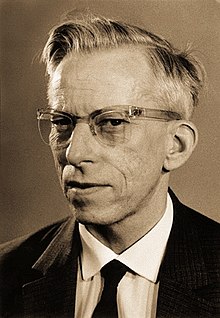Otto Wichterle
Otto Wichterle (27 October 1913 Prostějov now in the Czech Republic – 18 August 1998) was a Czech chemist known for his invention of modern soft contact lenses.

Life
changeHe decided to be a chemist after his father, which co-owned a farm machine factory. He graduated from high school in Prostějov and then he studied at the Chemical and Technological Faculty of the Czech Technical University. After he got his diploma he wanted to continue in his studies, but the Protectorate regime didn't let him do so. Fortunately, he could continue in his scientific work because he was able to take part in the research institute at Baťa's works in Zlín. His team made the first Czechoslovak synthetic fiber called silon. He was arrested by the Gestapo in 1942 but was released few months later. After World War II he returned to the university and started teaching general and inorganic chemistry. He wrote an inorganic chemistry textbook and German and Czech organic chemistry textbook. In 1952 he was made the dean of the Institute of Chemical Technology in Prague.
Development of contact lenses
changeOtto studied the synthesis of cross-linking hydrophilous gels. He wanted to find a perfect material that can be in permanent contact with living tissues. His colleague Drahoslav Lím helped him and together they prepared a gel. This gel absorbed up to 40% of water and was transparent. This new material is the Poly(2-hydroxyethyl methacrylate). They patented it in 1953. Wichterle thought that it might be a good material for contact lenses and gained his first patent for soft contact lenses. In 1957 Wichterle produced around 100 soft lenses. The problem was that the edges tore when the lens was getting removed. He wanted to find a better way to make them. Unfortunately, he was forced to leave the Institute of Chemical Technology because of its Communist leadership in 1958. So the research at the Institute came to an end, but he did the important experiments to transform hydrogels into a good shape of a contact lens by himself at home.
By late 1961 produced the first four hydrogel contact lenses on a home-made apparatus built from children's building kit (Merkur). All the glass tubing was also made by himself. On Christmas afternoon he finally made a contact lens in his apparatus. He tried the lenses in his own eyes. He said that they were comfortable. He built more new prototype machines using Merkur toys Archived 2011-12-13 at the Wayback Machine with stronger motor taken from his gramophone. With these devices he made 5,500 lenses.
Achievements and legacy
changeWichterle was well-known all around the world not only because of his achievements but also because of his activities in international organizations. He is the author of a large number of studies. He is the author or co-author of approximately 180 patents and of over 200 publications.
In 1970, Wichterle was expelled again from his position in the institute, this time for signing "The Two Thousand Words" . Full recognition did not come until the Velvet Revolution in 1989. In 1990, he was made president of the Czechoslovak Academy of Sciences and was the honorary president of the Academy of Sciences of the Czech Republic after that. Wichterle was a member of a number of foreign academies of science, he received many awards and honorary doctorates from several universities.
The asteroid number 3899 was named after Wichterle in 1993. A high school in Ostrava was named after him on September 1, 2006.